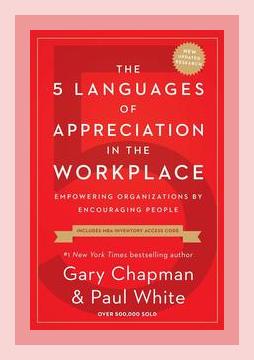Human Resources and Talent ManagementEmployee Engagement
Introduction
“The 5 Languages of Appreciation in the Workplace” by Gary Chapman and Paul White extends the core concept of Chapman’s widely recognized “The 5 Love Languages” to the organizational context. It emphasizes the importance of expressing appreciation to employees in personalized ways to enhance employee engagement, reduce turnover, and foster a positive work environment. The book outlines five distinct languages of appreciation and offers practical strategies for implementing these in the workplace.
1. Words of Affirmation
Key Points:
- Words of Affirmation involve verbal or written expressions of praise and acknowledgment for an employee’s contributions.
- Specificity and sincerity are critical. General praise can come off as insincere or unimpactful.
Examples from the Book:
- A manager compliments an employee for a specific, well-done project, saying, “You did an excellent job organizing the team meeting last week. Your agenda was clear, and you kept everyone on task.”
- Written affirmations, such as a handwritten thank-you note recognizing an employee’s exceptional performance, can be impactful.
Actionable Strategies:
- Schedule regular intervals to offer specific and constructive feedback.
- Use written communication (emails, notes) as well as verbal praises in team meetings or one-on-one interactions.
2. Quality Time
Key Points:
- Quality Time entails giving someone your focused attention. For some employees, spending quality time with their supervisors or colleagues is highly meaningful.
- This category includes active listening and engaging in shared activities.
Examples from the Book:
- A supervisor dedicates a portion of their schedule for one-on-one meetings with team members, discussing work progress and personal concerns.
- Organizing team-building activities such as a lunch outing, where the focus is on camaraderie rather than just business.
Actionable Strategies:
- Implement regular check-ins or mentoring sessions.
- Arrange occasional team outings or informal gatherings to foster relationships.
3. Acts of Service
Key Points:
- Acts of Service involve helping employees with their tasks or removing obstacles that might impede their work.
- The assistance should be willingly and sincerely offered, not out of obligation.
Examples from the Book:
- A manager steps in to help an overworked employee meet a tight deadline by assisting with specific tasks.
- Organizing support systems or tools that make employees’ tasks easier, like improving software or providing extra training.
Actionable Strategies:
- Observe where team members might need assistance and proactively offer help.
- Create a culture where team members feel comfortable asking for and offering help.
4. Tangible Gifts
Key Points:
- Tangible Gifts are small tokens of appreciation that are personally meaningful to the recipient.
- The value of the gift is secondary to the thought and effort that goes into selecting something meaningful.
Examples from the Book:
- Giving a book on a topic of interest to an employee who enjoys reading.
- Providing gift cards to favorite local restaurants or coffee shops.
Actionable Strategies:
- Create a list of employees’ preferences and hobbies to select appropriate gifts.
- Establish a small budget for spontaneous gift-giving tied to achievements or personal milestones.
5. Physical Touch
Key Points:
- Physical Touch in the workplace is highly contextual and should be approached with caution due to varying comfort levels and potential for misunderstandings.
- Appropriate forms might include a handshake, a pat on the back, or, in some cultures, a hug.
Examples from the Book:
- A congratulatory handshake after an employee receives a promotion.
- A supportive pat on the shoulder when someone has had a particularly tough day.
Actionable Strategies:
- Be mindful of cultural differences and personal space preferences.
- Reserve physical touch for instances where it is clearly welcomed and appropriate.
Implementing the Languages of Appreciation
Key Steps:
- Assess Preferences: Use tools such as the Motivating by Appreciation Inventory to determine employees’ preferred languages of appreciation.
- Communicate Intentions: Make it clear that the initiative to express appreciation is meant to enhance workplace morale and productivity.
- Custom Tailor Approach: Customize the appreciation strategies to align with individual preferences.
- Monitor and Adapt: Regularly solicit feedback to ensure appreciation efforts are impactful and make adjustments as necessary.
Examples from the Book:
- Conduct a company-wide survey to understand the appreciation preferences of employees.
- Regularly review the effectiveness of appreciation methods through team meetings and anonymous feedback forms.
Actionable Strategies:
- Develop a structured appreciation program based on identified preferences.
- Empower managers with the resources and training necessary to genuinely implement these appreciation languages.
Conclusion
“The 5 Languages of Appreciation in the Workplace” underscores that expressing appreciation in a personalized way can significantly boost employee engagement, job satisfaction, and retention. By identifying and effectively using the five languages—Words of Affirmation, Quality Time, Acts of Service, Tangible Gifts, and Physical Touch—leaders can create a more positive and productive work environment. The critical takeaway is that appreciation, when tailored to individual preferences and delivered consistently, becomes a powerful tool in strengthening workplace relationships and organizational success.
Final Action Plan:
- Start by educating leadership and staff on the five languages.
- Use inventories and surveys to identify each employee’s preferred appreciation language.
- Integrate personalized appreciation practices into daily management routines.
- Regularly evaluate and adapt your approach to ensure continuous improvement and sustained engagement.
